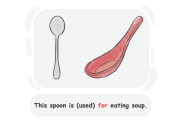Expressing Purpose

How to Express Purpose?
Expressing purpose is a way to convey the reason or intention behind an action or statement. By expressing our purposes, we can provide context for our actions and help others to understand why we are doing something.
Prepositions
Prepositions are used to connect the action or statement with the intended purpose or outcome. Some prepositions that can be used in this way include 'for', 'to', 'for the purpose of', and 'for the sake of'.
For
This preposition is commonly used to indicate the purpose or reason for an action or state. It can be followed by a noun phrase and explain the purpose of an action. It can also be followed by a gerund to answer the question 'What is this thing (used) for?'. Pay attention to the examples:
We went to the bar for a drink.
She is taking Spanish classes for her job.
This spoon is (used) for eating soup.
To
'To' is a preposition that is often used to express purpose in English. When used in this way, it connects the action or statement with the intended purpose or outcome. For example:
I am saving money to buy a new car.
I am exercising every day to improve my health.
Warning!
Do not confuse the preposition 'to' with the infinitive marker 'to'. While both are followed by the base form of the verb, the preposition 'to' that is used to express purpose forms a prepositional phrase that acts as an adverb of purpose. Also, it can be replaced with other prepositions and follow 'in order' or 'so as' to express purpose. One way to distinguish between the infinitive marker 'to' and the preposition 'to' is to check if you can change the place of clauses in the sentence. Compare the examples:
I am going to work out today. → to-infinitive
you can't say 'To work out today I am going.'
I work out every day to stay fit → preposition of purpose
You can also say 'To stay fit, I work out every day'
They like to drink a cup of tea. → to-infinitive
you can't say 'to drink a cup of tea they like'.
I need a minute to drink a cup of tea → preposition of purpose
You can say 'To drink a cup of tea, I need a minute.'
In Order To and So As To
'In order to' and 'so as to' are two expressions that use the preposition 'to' and are mostly used in more formal contexts to express purpose. 'In order to' and 'so as to' are similar in meaning, and can often be used interchangeably. Also, you can replace them by 'to'. For example:
I am taking this course in order to improve my writing skills.
I am studying hard in order to pass the exam.
I am waking up early so as to exercise before work.
I am taking this course so as to improve my job prospects.
For the Purpose Of
This preposition is used to express the specific purpose or end goal of an action. For example,
I am volunteering for the purpose of helping others.
We are implementing this new policy for the purpose of increasing efficiency.
We are organizing this event for the purpose of raising funds for charity.
For the Sake Of
This preposition is used to express the purpose or benefit of an action. It is typically used to indicate that an action is being taken for the benefit of someone or something else, or for a particular desirable outcome. For example:
I am working hard for the sake of my family.
I am giving up smoking for the sake of my health.
Conjunctions
Conjunctions are also used to express purpose in English.Some of the conjunctions that are commonly used to express purpose include so (that), in case, and lest.
So (that)
'So' is often used to indicate the reason behind an action or statement. It is a coordinating conjunction and thus is always followed by another independent clause. For example,
I am studying hard so (that) I can pass the exam.
I am saving money so (that) I can go on vacation.
In Case
The subordinating conjunction 'in case' is used to express the purpose of taking a precautionary action or being prepared for a possible situation. Pay attention to the examples:
I am bringing an umbrella in case it rains.
I am bringing extra snacks in case we get hungry on the road.
I am leaving early in case there is traffic on the way.
Lest
'Lest' is a conjunction that is used to express a negative purpose or intention. It is often used in formal context to indicate that an action is being taken to prevent a negative outcome or to avoid potential danger or harm. For example:
I am being careful with my diet, lest I gain weight.
I am leaving early, lest I miss my flight.
Comments
(0)

